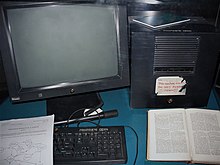NeXT Computer
 This NeXT workstation (a NeXTcube) was used by Tim Berners-Lee as the first Web server on the World Wide Web. | |
| Manufacturer | NeXT, Fremont, California |
|---|---|
| Type | Workstation |
| Release date | October 12, 1988 |
| Introductory price | US$6,500 (equivalent to $16,746 in 2023) |
| Discontinued | 1990 |
| Operating system | NeXTSTEP, OPENSTEP |
| CPU | Motorola 68030 @ 25 MHz, 68882 FPU @ 25 MHz, 56001 digital signal processor (DSP) @ 25 MHz |
| Memory | shipped with 8 MiB, expandable to 16 MiB using 1 MiB Single Inline Memory Modules (SIMMs) |
| Storage | 256 MiB magneto-optical drive, optional hard disk |
| Display | MegaPixel 17" monitor |
| Graphics | 1120×832 pixel resolution, four-level grayscale |
| Sound | built-in speakers |
| Input | 85-key keyboard, 2-button mouse |
| Connectivity | Ethernet |
| Power | 300 Watts, 3 Amperes |
| Dimensions | 1-foot (305 mm) die-cast magnesium cube-shaped case |
| Successor | NeXTcube |
The NeXT Computer (also called the NeXT Computer System) is a workstation computer developed, marketed, and sold by NeXT Inc. It runs the Mach- and BSD-derived, Unix-based NeXTSTEP operating system, with a proprietary GUI using a Display PostScript-based back end. The motherboard is square and fits into one of four identical slots in the enclosure. The NeXT Computer enclosure consists of a 1-foot (305 mm) die-cast magnesium cube-shaped, black case, which led to the machine being informally referred to as "The Cube". It was launched in 1988 at US$6,500 (equivalent to $16,700 in 2023).
The NeXT Computer was succeeded by the NeXTcube, an upgraded model, in 1990.
Reception
This section needs expansion. You can help by adding to it. (July 2014) |

|
 |
The NeXT Computer was not a significant commercial success, failing to reach the level of high volume sales like the Apple II, Commodore 64, the Macintosh, or Microsoft Windows PCs. The workstations were sold to universities, financial institutions, and government agencies.[citation needed]
Launch
The NeXT Computer was revealed at a lavish, invitation only, gala launch event "NeXT Introduction - the Introduction to the NeXT Generation of Computers for Education" at the War Memorial Opera House, San Francisco, California on Wednesday October 12, 1988. The following day, selected educators and software developers were invited (for $100 registration fee) to attend the first public technical overview of the NeXT computer at an event called "The NeXT Day" held at the San Francisco Hilton. This event gave developers interested in developing NeXT software an insight into the software architecture, object-oriented programming, and developing for the NeXT Computer. The luncheon speaker was Steve Jobs.
Legacy
A NeXT Computer and its object oriented development tools and libraries were used by Tim Berners-Lee and Robert Cailliau at CERN to develop the world's first web server software, CERN httpd, and also used to write the first web browser, WorldWideWeb.
The NeXT Computer and the same object oriented development tools and libraries were used by Jesse Tayler at Paget Press to develop the first electronic AppStore The Electronic AppWrapper in the early 1990s. Issue #3 was first demonstrated to Steve Jobs at NeXTWorld Expo 1993.
See also
- Previous, emulator of NeXT hardware
- NeXTstation
- NeXTcube
- NeXTcube Turbo
External links
- Byte Magazine, November 1988: The NeXT Computer Facsimile, Full text
- Simson Garfinkel's NeXT pages including NeXTWorld Magazine
- The Best of NeXT Collection
- NeXT Computer brochure (page 7 contains a full size image of the circuit board)
- old-computers.com — NeXTcube
- Photos of black hardware

